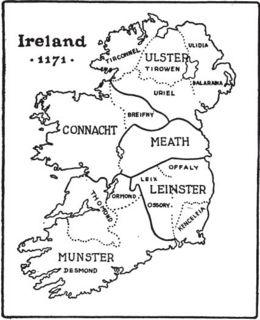Provinces of Ireland: Difference between revisions
imported>Anton Sweeney (Add appropriate cats) |
imported>Anton Sweeney (Add image of traditional provinces) |
||
| Line 1: | Line 1: | ||
[[Image: | [[Image:Ireland-1171.jpg|thumb|260px|Ireland in 1171 showing the traditional provinces. Map by Harald Toksvig]] | ||
The '''Provinces of Ireland''' are ancient subdivisions of the island of [[Ireland (island)|Ireland]]. Originally five in number (the [[Irish language|Irish]] name for 'province' is ''cúige'', meaning "fifth"), the smallest province, Meath, was eventually absorbed into the neighbouring province of Leinster. | The '''Provinces of Ireland''' are ancient subdivisions of the island of [[Ireland (island)|Ireland]]. Originally five in number (the [[Irish language|Irish]] name for 'province' is ''cúige'', meaning "fifth"), the smallest province, Meath, was eventually absorbed into the neighbouring province of Leinster. | ||
Each province is further subdivided into a number of counties. While the provinces have no legal designation in either the [[Ireland (state)|Republic of Ireland]] or [[Northern Ireland]], they continue to be important in sporting contexts, especially in [[Gaelic Athletic Association|Gaelic games]] and [[Rugby union]]. | Each province is further subdivided into a number of counties. While the provinces have no legal designation in either the [[Ireland (state)|Republic of Ireland]] or [[Northern Ireland]], they continue to be important in sporting contexts, especially in [[Gaelic Athletic Association|Gaelic games]] and [[Rugby union]]. | ||
The four provinces, together with their traditional [[Counties of Ireland|counties]], are: Leinster in the east, Munster in the south, Connacht in the west, and Ulster in the north. The former province of Meath had borders roughly analagous to the modern counties of Meath and Westmeath. | The four modern provinces, together with their traditional [[Counties of Ireland|counties]], are: Leinster in the east, Munster in the south, Connacht in the west, and Ulster in the north. The former province of Meath had borders roughly analagous to the modern counties of Meath and Westmeath. | ||
=='''Leinster'''== | =='''Leinster'''== | ||
[[Image:IrelandProvincesNumbered.png|thumb|250px|The provinces of Ireland are: 1. Leinster, 2. Munster, 3. Connacht, 4. Ulster.]] | |||
* [[County Carlow|Carlow]] | * [[County Carlow|Carlow]] | ||
* [[County Dublin|Dublin]] (This traditional county has now been abolished, being replaced by [[Dublin|Dublin city]], [[Dun Laoghaire-Rathdown]], [[Fingal]] and [[South Dublin]]) | * [[County Dublin|Dublin]] (This traditional county has now been abolished, being replaced by [[Dublin|Dublin city]], [[Dun Laoghaire-Rathdown]], [[Fingal]] and [[South Dublin]]) | ||
Revision as of 17:40, 5 September 2007
The Provinces of Ireland are ancient subdivisions of the island of Ireland. Originally five in number (the Irish name for 'province' is cúige, meaning "fifth"), the smallest province, Meath, was eventually absorbed into the neighbouring province of Leinster.
Each province is further subdivided into a number of counties. While the provinces have no legal designation in either the Republic of Ireland or Northern Ireland, they continue to be important in sporting contexts, especially in Gaelic games and Rugby union.
The four modern provinces, together with their traditional counties, are: Leinster in the east, Munster in the south, Connacht in the west, and Ulster in the north. The former province of Meath had borders roughly analagous to the modern counties of Meath and Westmeath.
Leinster
- Carlow
- Dublin (This traditional county has now been abolished, being replaced by Dublin city, Dun Laoghaire-Rathdown, Fingal and South Dublin)
- Kildare
- Kilkenny
- Laois
- Longford
- Louth
- Meath
- Offaly
- Westmeath
- Wexford
- Wicklow
Munster
- Clare
- Cork
- Kerry
- Limerick
- Tipperary (This traditional county has now been abolished, being replaced by North Tipperary and South Tipperary
- Waterford
Connacht
Ulster
Six of the nine Ulster counties (Antrim, Armagh, Down, Fermanagh and Londonderry) are within Northern Ireland, while the remaining three (Cavan, Donegal and Monaghan) are within the Republic of Ireland.

